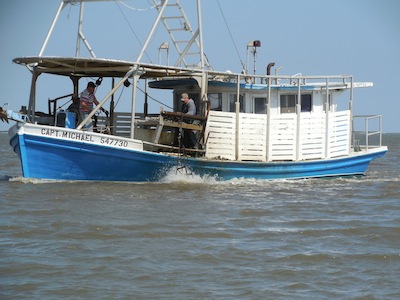I never really thought about it this way before, but at National Fisherman, I’m working by watching you work. And while I’m watching you work, writing down what you’re saying and trying to understand technical details about fishing and gear, I can’t help but also wonder, “Could I do that job?”
No. Usually I don’t have to think hard about the answer. I love being out on the water, and the excitement of the net coming up with a mystery inside, but I can’t do what you do. A day on the water leaves me so tired I feel lucky to stay awake long enough to make the drive home and collapse into bed.
On Monday. I boarded a 22-foot Blackjack that took us through Louisiana’s Bayou Dularge to an oyster reef. It was my first time to the Gulf, and the inland fisheries surprised me. In the Northeast, where I’m from, most fishing takes place hours from shore. In Louisiana, waterways run alongside streets and through backyards; fishing feels like part of the neighborhood here, like the grocery store.
At least I could handle being on the water. The bayou wound through still waters. Ripples on the open water were smaller than the wake caused by passing boats, even a tiny crab boat, with two guys and a white bucket of blue crab they had hauled up from one of the many crab pots that dotted the waters.
The bayou is a bustling workplace though. As we headed out we passed shrimp boats docked and ready for the inshore season that starts next week. Here and there, a single conveyer belt along the shore showed us where sacks of oysters would be unloaded onto trucks. When we passed a gas station, a big black and white spotted pig shuffled inside a wire cage.
We left the shores behind when we finally made it to the open water and approached four oyster boats. The lake was quiet except for a hammering sound that we could hear as we got closer to the boats: a constant clink, clink, clink, clink, clink.
That was the sound of oystermen at work. I watched the oystermen hauling up dredges that scraped the tops of the beds below. Two men open the dredge, dumping the oysters onto a table, drop the dredge back into the water, and immediately they began hammering the big clumps, pounding the oysters apart and shoving them into growing piles on deck. Repeat. I was told that their work also includes hauling up big piles of oysters and moving them to other reefs where they can be more productive.
Our skipper, a charter boat guy known as ‘Lil Coon, shook his head watching them. He couldn’t do that, he told us. Being on an oyster dredge is a full day of hauling up the oysters, pounding them apart and sacking them up. I feel a twinge in my back thinking about it, all day long. These fishermen may not be rolling on a big sea, and they’re able to go home to bed at night, but I know I couldn’t do their jobs either.
I’ve learned a lot about commercial fishing at National Fisherman. What I’m learning is that if it’s not hard one way, then there’ll be something else to make up for that. It’s backbreaking, dangerous, dirty work. Not everyone can do it, but I feel privileged to be able to watch.







